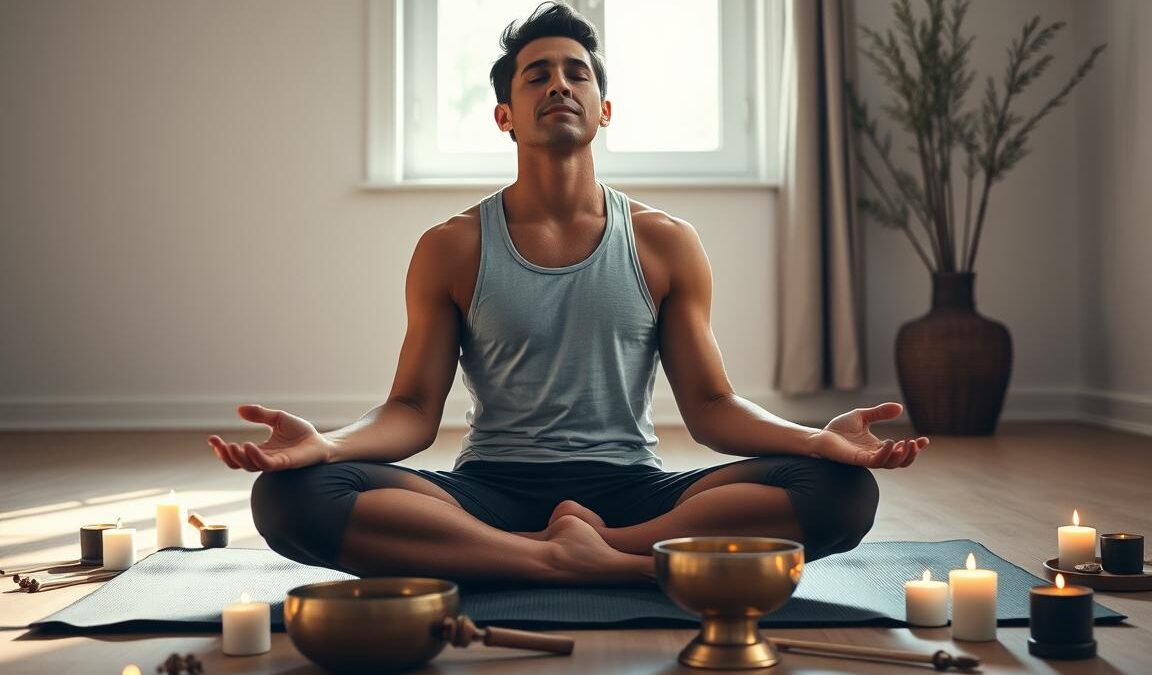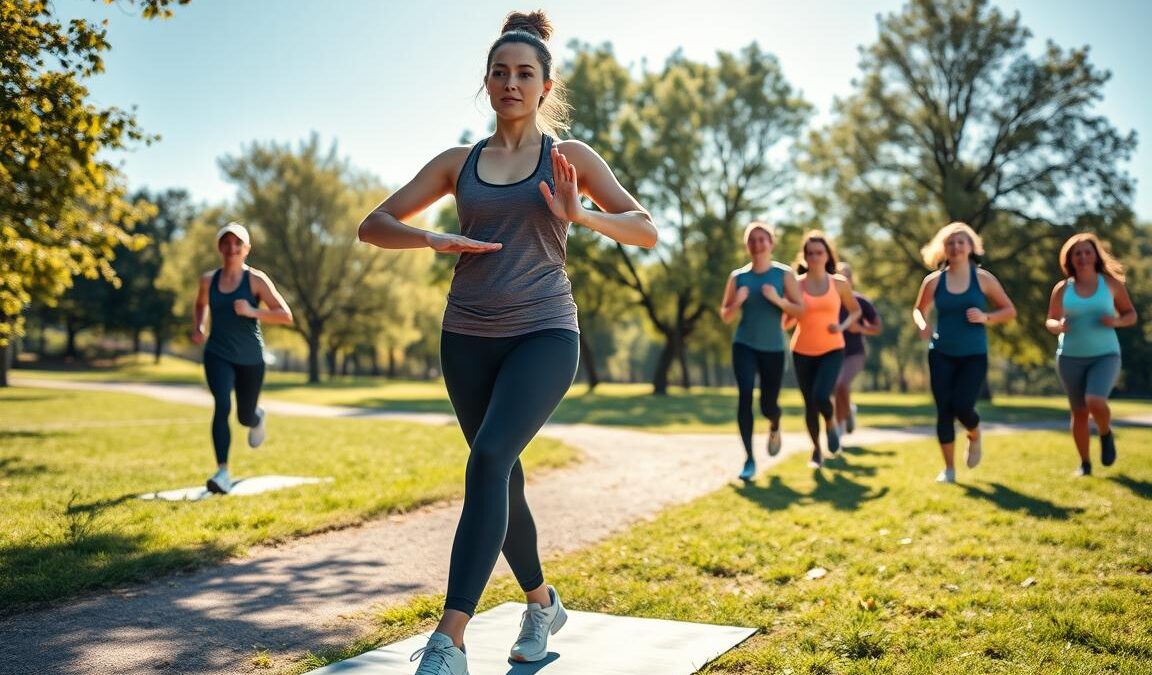
Mindfulness Techniques for Athletes to Boost Performance and Focus
The phrase “mindfulness techniques for athletes” isn’t a slogan — it’s a practical way to steady your mind and lift athletic performance in tight moments.
Simple breathing and short meditation practices can cut stress, sharpen attention, and make every rep and play feel clearer. Box Breathing — inhale four, hold four, exhale four, hold four — is one quick tool you can add to warm-ups or timeouts to steady focus.
Body scans and mindful walking speed recovery and rebuild body awareness after hard training. Visualization pairs well with physical rehearsal, helping you rehearse success and reduce game‑day anxiety.
Research even shows team players who used guided attention drills improved measurable outputs like goals and coach ratings. If you want practical steps you can start today, check a short primer on mental toughness here.
Key Takeaways
- Short daily practice steadies attention and reduces stress.
- Box Breathing and quick meditation fit into warm‑ups and timeouts.
- Body scans aid recovery and body awareness after training.
- Visualization lowers anxiety and sharpens performance under pressure.
- Research links guided attention practice to better on‑field results.
- Five to twenty minutes daily makes these tools stick.
Why present-moment awareness is a competitive edge in sport
In clutch moments you don’t need to erase nerves — you need to bring attention back to what matters. Under pressure your mind will jump to “What did I just miss?” or “What if I fail next play?” That shift steals your view of the task.
Sport psychology shows even top athletes get intrusive thoughts. The practical answer is simple: train attention like a skill. A short meditation or focused breathing drill in training builds that ability over time.
The 3R flow—register, release, refocus—gives you a repeatable way to catch wandering thoughts, let them go without judgment, and return attention to the task. You don’t need to be calm to perform. You need to be able to refocus under pressure.
- Notice the thought (register).
- Let it pass; don’t chase it (release).
- Bring focus back to the moment and the next action (refocus).
| State | What you do | Likely outcome |
|---|---|---|
| Distracted | Replay mistakes | Slower decisions |
| Present | See options | Better performance |
| Trained | Refocus fast | More consistent results |
mindfulness techniques for athletes
Use short, sensory-based routines to sharpen focus and speed recovery on busy days.
Mindful breathing for game-ready calm
Sit or stand upright. Place a hand on your belly and feel air move in and out. Do Box Breathing: inhale 4, hold 4, exhale 4, hold 4.
When: 2–4 cycles during warm‑ups or timeouts. Why: it steadies attention and lowers stress without sedation.

Body scan meditation to boost body awareness and recovery
Lie down after training or before bed. Scan from scalp to toes. Pause on tight spots, soften jaw and shoulders, and breathe into tense areas.
Timing: a 10‑minute run helps recovery and reveals areas that need care.
Mindful walking and visualization
On rest days, notice foot strike, cadence, and sounds. Return to step sensations when thoughts drift.
Before practice or a game, spend 2–5 minutes imagining a key skill. Add grip, ground contact, and crowd cues. End with the desired outcome to cut performance anxiety.
Mindful eating, the 3R process, and fitting practice into a busy schedule
Take the first two minutes of a meal to notice taste and fullness. Match portions to hunger and slow the pace to improve digestion and energy.
The 3R: register a wandering thought, release it with a neutral label, then refocus on the next task cue (breath, target, footwork).
Formal vs. informal: set aside 5–10 minutes for guided meditation and use short cues during drills so the ability transfers to competition.
- Quick takeaway: two short habits a day build attention and better athletic performance.
Applying mindfulness in training, competition, and recovery
A few focused breaths and a single cue can turn a scattered warm-up into a game-ready routine.
Pre-practice and pre-game: take 60–90 seconds for two cycles of Box Breathing. Then name one clear attention cue—like “hips through” or “eyes on seam”—and repeat it aloud once. For a game, extend to a 3-minute routine: two breath cycles, a quick visualization of the opening play, and press your toes into the ground as a physical anchor to bring you to the present moment.
In-competition cueing
Use 3R micro-loops: register a drifting thought, release it with a single exhale, then refocus on the task with a short cue like “shoulder square.”
- Build a cue list for pressure spots (free throws, faceoffs, penalty kicks).
- On a game break, scan head-to-toe for 10 seconds, relax jaw and shoulders, take one steady breath.
Post-session recovery
Lie down for a 5–10 minute body scan. When you find tightness, note it without judgment and pair it with slow exhales to ease stress and speed recovery.
- Integrate short, informal practice into drills: pick one movement quality and return to it when thoughts wander.
- Track controllable outcomes (quality reps, executed cues) and finish each day with one-line reflection to improve athletic performance over time.
What the research says about focus, performance, and wellbeing
When you train attention, measurable gains follow — in stats, coach ratings, and how you feel.
Evidence from sport psychology shows structured attention work changes outcomes in real games. In a randomized trial with Swedish hockey players, acceptance and focused training raised goals, assists, and shots. Coaches also rated players higher on focus and commitment.

Why elite minds still wander — and how they refocus
Even top performers report intrusive thoughts under pressure. The 3R loop — register, release, refocus — gives you a fast, repeatable way to return attention to the task.
Youth and brain changes
School research led by John Gabrieli at MIT found students who practiced short sessions felt calmer and showed brain shifts in emotion and thinking areas. That maps to better concentration and lower stress, which helps recovery and long‑term training.
- Practical takeaway: notice mind wandering, use a present‑moment cue, and repeat the cue in practice.
- Better attention under pressure means fewer missed reads and steadier execution late in events.
| Study | Key outcome | Practical use |
|---|---|---|
| Swedish hockey RCT | More goals, assists, shots | Short attention drills in warm‑ups |
| Elite athlete reports | Wandering mind common | 3R micro‑loops during breaks |
| MIT youth study | Less stress, brain changes | Daily short practice to build focus |
How to get started and build a sustainable mindfulness practice
A simple, repeatable routine you can do in ten minutes will shift training outcomes over weeks. Start small and build trust with the process.
The 10-minute sweet spot: realistic daily routines
Ten minutes a day gives measurable benefits in stress control, attention, and recovery without adding time pressure to your schedule.
Try this weekly ramp: two minutes of quiet breathing the first week, five minutes guided the next, and a steady 10-minute practice by week four.
Beginner-friendly progressions: breath to visualization
Layer skills in three steps: breath awareness, short body scan, then a 2–3 minute visualization of a key skill. Each step adds ability without overload.
Coach- and parent-approved tools
- Inner Explorer — team-friendly, school-tested sessions.
- Calmer Choice — coach resources and short lessons.
- Headspace — approachable sessions you can use at home or on the road.
Common obstacles and simple fixes
If thoughts wander, notice them and return to one short cue. That noticing is the progress.
No time? Pair attention drills with warm-ups or cooldowns so the practice is automatic.
| Challenge | Quick fix | Why it works |
|---|---|---|
| Wandering thoughts | Label once, return to cue | Builds attention by repetition |
| Not enough time | 2–3 minute mini-reset | Fits busy schedules and resets stress |
| Practice fades | Block it like a workout | Creates habit and consistency |
| Motivation dips | Rotate exercises weekly | Keeps practice fresh and enjoyable |
Quick plan: track minutes and one daily cue. Small, steady practice beats sporadic effort and helps you get started and keep going.
Conclusion
Consistency, not perfection, is the secret to steadier performance and sharper attention. You don’t need perfect calm to perform. A few minutes a day trains your mind to return to what matters.
Pick one simple tool today—Box Breathing, a 10‑minute body scan, or a two‑minute visualization—and attach it to your next training session. Use a short cue in practice and games to refocus fast.
Recover with a quick scan so your body and mind reset and you’re ready tomorrow. The research and real results line up: small, steady steps in mindfulness boost focus and athletic performance you can feel.
Start now, stay consistent, and watch how your performance and confidence grow.



